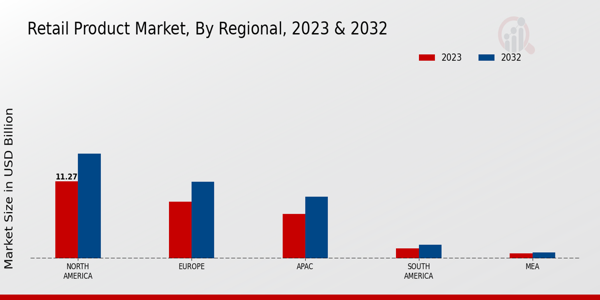E-commerce Growth
The rapid expansion of e-commerce platforms is a pivotal driver in the Global Retail Product Market Industry. As consumers increasingly prefer online shopping for its convenience, the market is projected to reach 30.2 USD Billion in 2024. This shift is evident in the growing number of digital transactions, which have surged significantly in recent years. Retailers are adapting by enhancing their online presence and optimizing logistics to meet consumer demands. The integration of advanced technologies, such as AI and machine learning, further personalizes the shopping experience, potentially increasing customer loyalty and retention. This trend indicates a robust future for the industry as e-commerce continues to evolve.
Sustainability Trends
Sustainability has emerged as a crucial driver in the Global Retail Product Market Industry, influencing consumer purchasing decisions. As awareness of environmental issues grows, retailers are increasingly adopting sustainable practices, such as eco-friendly packaging and ethically sourced materials. This shift not only caters to the environmentally conscious consumer but also aligns with regulatory pressures for sustainable operations. Companies that prioritize sustainability may experience enhanced brand loyalty and market share. The industry's focus on sustainability is expected to contribute to its growth, with projections indicating a market size of 43.2 USD Billion by 2035. This trend suggests a long-term commitment to environmental responsibility within the retail sector.
Market Growth Projections
The Global Retail Product Market Industry is poised for substantial growth, with projections indicating a market size of 30.2 USD Billion in 2024 and an anticipated increase to 43.2 USD Billion by 2035. This growth trajectory suggests a compound annual growth rate of 3.32% from 2025 to 2035. Various factors, including technological advancements, changing consumer preferences, and sustainability trends, are expected to drive this expansion. The market's resilience and adaptability to evolving consumer demands indicate a promising outlook for stakeholders in the retail sector. These projections highlight the dynamic nature of the industry and its potential for continued growth.
Technological Advancements
Technological advancements are reshaping the Global Retail Product Market Industry, driving efficiency and enhancing customer experiences. Innovations such as augmented reality, virtual fitting rooms, and mobile payment solutions are becoming increasingly prevalent. These technologies not only streamline operations but also provide consumers with interactive and personalized shopping experiences. Retailers leveraging these advancements may see improved sales and customer satisfaction. As technology continues to evolve, it is likely that the industry will witness further transformations, potentially leading to a compound annual growth rate of 3.32% from 2025 to 2035. This ongoing technological integration indicates a dynamic future for the retail landscape.
Changing Consumer Preferences
Changing consumer preferences are a significant driver in the Global Retail Product Market Industry, as shoppers increasingly seek personalized and unique products. This shift is prompting retailers to diversify their offerings and enhance customer engagement strategies. The rise of social media and influencer marketing has further amplified this trend, allowing brands to connect with consumers on a more personal level. Retailers that successfully adapt to these evolving preferences may capture a larger market share. As the industry continues to respond to these changes, it is anticipated that the market will grow substantially, reflecting the dynamic nature of consumer behavior in retail.
Global Supply Chain Optimization
Global supply chain optimization plays a critical role in the Global Retail Product Market Industry, particularly as retailers strive to enhance efficiency and reduce costs. By streamlining logistics and inventory management, companies can respond more effectively to consumer demands and market fluctuations. The adoption of advanced analytics and real-time tracking technologies is enabling retailers to optimize their supply chains, resulting in improved delivery times and customer satisfaction. This focus on supply chain efficiency is likely to contribute to the overall growth of the industry, as retailers position themselves to meet the challenges of a rapidly changing market landscape.


























Leave a Comment